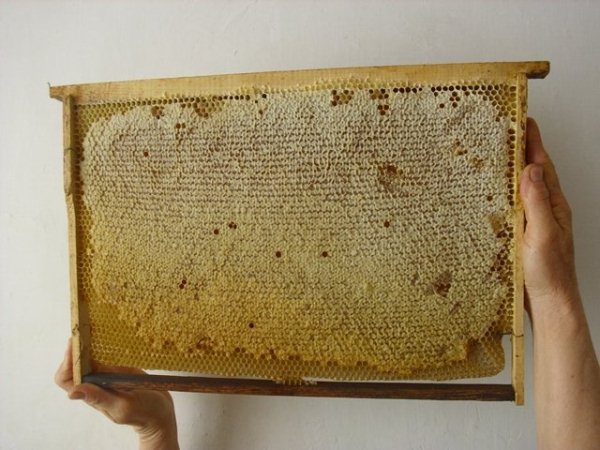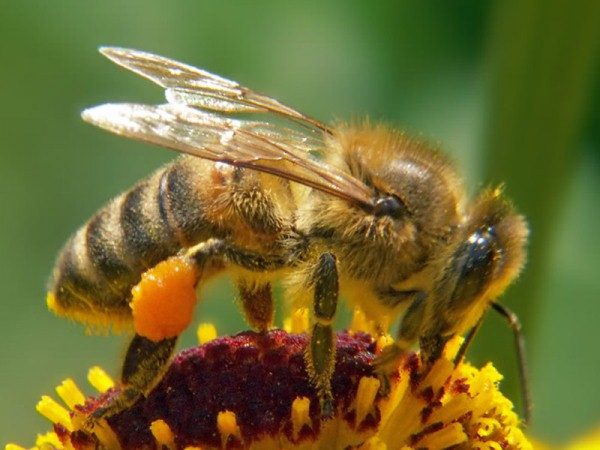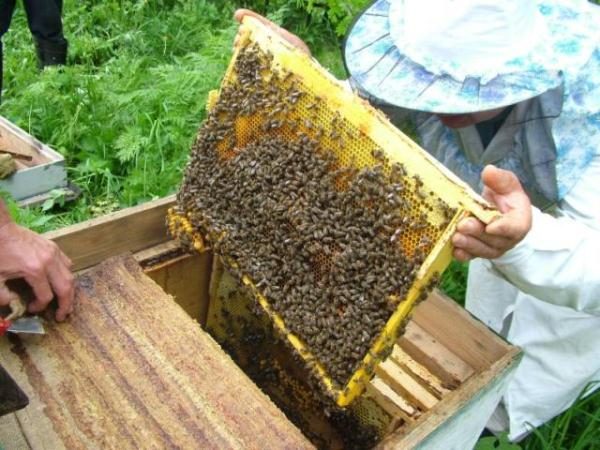Honey - natural products of bees, It contains most of the healing vitamins and properties.. It has an irreplaceable taste and an amazing smell, honey can be taken as a separate product, or with a variety of foods, and also based on it are made therapeutic compounds with the addition of various products. But not all fans of this delicacy know how and where it comes from and who makes the honey. This is a long and laborious process.
Table of contents
How do you make honey
The process of extraction of honey takes place in 4 stages:
- worker bees chew nectar long and hard and add enzymes to it. Sugar is broken down into fructose and glucose, which makes the product more digestible. Bee saliva has antibacterial properties that contribute to the decontamination of nectar and the extension of honey storage;
- finished products placed in pre-prepared cellswhich are filled at 2/3;
- after begins moisture evaporation process. Insects flap their wings, which increases the temperature. Over time, the moisture disappears, forming a viscous syrup;

- honeycomb with substance hermetically sealed with wax plugs, and in the created vacuum honey reaches full maturity. Wax jams contain secretion of bee saliva, which disinfects the cell, preventing the fermentation of the finished product.
Why do bees harvest honey?
There are several options for answering the question why:
Nectar and further honey are the main carbohydrate food for these insects.
Another answer is feeding needs of brood larvae. From the 4th day youngsters start to feed on a combination of water, pollen and honey. The uterus after its birth, also consumes honey food or a mixture of sugar and honey. What else do bees produce honey for? This product is an inexhaustible source for bee colonies, it produces the necessary amount of heat to maintain the necessary temperature in the hives (34-35 ° C).

Bees, while collecting food, are dragging pollen on their paws, contributing to fertilization of honey plant seeds. For the whole summer they fly from flower to flower, carrying out the so-called fruitful “collaboration”.
How to collect honey?
No less interesting is the process of accumulating honey. Before the bees start honey collection, they get warning from scout beeswhich side is the honey collection and what is the distance to it. At this point, the bee-gatherers are ready to “start”,waiting for a certain signal from scout bees. Upon the return of the first such bee to the apiary, insects receive information using information movements (beekeepers recently called it bee "dances") about the beginning of the honey harvest. The insect very quickly makes an incomplete circle around the honeycomb, then flies in a straight line, wagging its womb, and again makes a semicircle, but in the opposite direction.
If show bee "dance" on white paper, the figure eight is formed. In order for all honeybees to fly in for warning movements, the scout repeats the signaling movements several times. In addition to this, the “dance” ceremony involves the attraction of several gathering bees, who make exactly the same movements, touch her belly, and sometimes take fresh nectar from her. Motion signaling lead all bees in the hive to the active state. After delivering fresh nectar to the bees, the scout flies back, followed by the rest of the insects mobilized and prepared for the start of their labor activity.
Scout bees look for new places every day to collect nectar, where honey plantings with a high concentration of sugar in nectar.Sometimes bad weather becomes an obstacle for the honey collection, making a forced break, and the flowering bees who arrive for pollen return empty. Insects make observations and wait for the resumption of nectar excretion to notify the family.
What is honey for?
Honey is essential for health and for the human body as a whole. It has the ability to stabilize and improve the condition of most organs., strengthens protective functions, improves blood circulation, slows down the aging process, is a powerful source of energy.
Beneficial features due to its origin and complex chemical components. Honey is known for its healing, antiviral, invigorating functions, due to which it is widely used in medicine.
How much honey does a bee colony collect?
In each hive lives one bee swarm with a queen. For collecting honey, 11–12 frames are standardly placed in a box.. With one such frame you can download about 1.5-2 kg of products.This means that up to 18 kg of a unique honey delicacy is collected in one ordinary hive. But when downloading honey, beekeepers do not often get that amount of honey. So, as insects copiously fill the middle of the honeycomb, and the outermost cells are left half full. Therefore, from one hive it is possible to get 13-14 kg of honey products.

During the hot or rainy season, the amount of honey from one family does not even reach such a coefficient. Bees diligently collect nectar, but with a small number of honey plants, time is spent more, and the cells fill up more slowly. In such situations, with a single pumping yield of 7-10 kg.
Honey collection - the main occupation of bees. All efforts of the bee colony are aimed at collecting nectar and further harvesting honey products. Each individual of the family has certain functions, but despite this, their common goal is honey.

Very interesting article about the extraction of honey. Everything is written in detail. Especially liked the video. I learned a lot about the properties of this useful product. Separate praise for the cheerful mood deserves a dance of bees)))